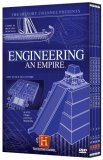| Reviews & Columns |
|
Reviews DVD TV on DVD Blu-ray 4K UHD International DVDs In Theaters Reviews by Studio Video Games Features Collector Series DVDs Easter Egg Database Interviews DVD Talk Radio Feature Articles Columns Anime Talk DVD Savant Horror DVDs The M.O.D. Squad Art House HD Talk Silent DVD
|
DVD Talk Forum |
|
|
| Resources |
|
DVD Price Search Customer Service #'s RCE Info Links |
|
Columns
|
|
|
History Channel: Engineering an Empire, The
You have to hand it to The History Channel. The 24-hour TV channel devoted to telling the stories of our near and ancient past has been on the air since 1995. That's a lot of programming hours. Now of course, there's more than enough historical subjects out there to fill such a number a thousand times over. But there's no question that certain milepost subjects are going to keep coming up on the schedule: ancient Greece, the Renaissance, World War II, and so on. So how do you keep coming up with new and different ways of looking at the same big historical events? How do you manage to produce shows that are fresh and entertaining, when the subject may have already been covered in dozens of other programs on the very same channel?
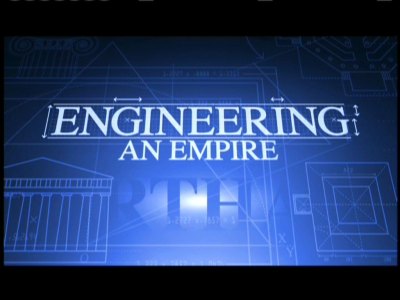
One of The History Channel's newest programs (it debuted this past year), Engineering An Empire, looks at various civilizations throughout history, and examines the buildings, structures, and machines those civilizations developed that aided their transformations into empires. Utilizing interviews with historical experts in each particular field, along with on-site location shooting and stunning CGI recreations of those empires' engineering feats, Engineering An Empire manages to shine new light on subjects you may have assumed were tapped out from repetition. The use of CGI animated blueprints, buildings, cities and war machines, is an enormously helpful way of illustrating concepts for viewers who might have otherwise not grasped their importance from simple two-dimensional drawings.
While Engineering An Empire may not look too dissimilar from other recent History Channel programs in its design or structure (such as Lost Worlds), it does have one big difference that really makes it stand out: host Peter Weller. Michael Carroll lends his distinctive, familiar voice for the narration on these episodes, but host Weller pops up throughout the shows, speaking either directly to us, or to the experts, as he enthuses about the various featured civilizations and engineering feats. And that's what makes Engineering An Empire really pop for the audience: Weller's obvious enthusiasm. When I saw that Weller, the actor probably best known for his lead role in Robocop, was hosting this show, I just assumed it was another acting gig for him. But when I saw the show's premiere episode, and Weller came onscreen for the first time, a little blurb underneath his name said, "Syracuse University," not unlike the other experts on the show who had their job affiliation listed, as well. I did a little research, and I found that Weller held a Master's Degree in Roman and Renaissance Art, and that he indeed lectured regularly at Syracuse University.
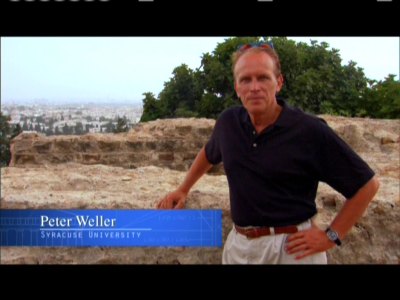
So when Weller speaks with passion and animation about these ancient arts and feats of invention, he really knows what he's talking about. This isn't just an actor reading lines prepared for him by someone else. It's not an act; you can't fake that kind of engagement with the material. He talks the talk, but he also walks the walk, and that extra sense of involvement with the material really raises the interest level of Engineering An Empire. Far from the usually staid or even anonymous hosts or narrators that grace most of these history programs, Weller is obviously pumped to be on this show. You can see him getting jacked up when a particular piece of information, or a person in history he admires, resonates with him, and that's instantly transmitted to the audience. And that enthusiasm is infectious -- and often humorous. When Weller, in the episode Greece: The Age of Alexander likens Philip II of Macedonia to a nerd wanting to hang with the frat boys of Athens, I laughed out loud -- when's the last time you did that watching a History Channel show? If you've ever sat in on a typical college history class, you can well imagine that Weller must be a very popular lecturer at Syracuse.
As for this particular boxed set, I did have one concern. The premiere episode of the series, Egypt, is not included in this box set. Why? I have no idea, but this special two-hour series premiere was truly spectacular, so why wasn't it included in this box set, making it a complete first season collection? The Egypt episode has already been released on DVD, so why not include it here, and help fuel sales for this box set by making it a complete collection? Its omission here is a shame, and it might very well affect sales for fans of the series who want the entire first season's 13 episodes in one collection.
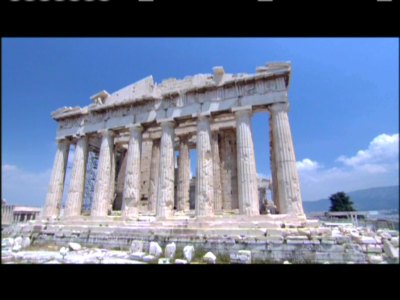
DISC ONE:
Greece
Western Civilization has been influenced by many cultures, but it was born in Ancient Greece. The Ancient Greeks laid a foundation that has supported nearly 3000 years of European history. Philosophers like Aristotle and Socrates, Olympian gods, the beginnings of democracy and great conquering armies can be attributed to the Ancient Greeks. This strong and charismatic people strategically harnessed the materials and people around them to create the most advanced technological feats the world had ever seen. From The Tunnel of Samos: a mile-long aqueduct dug through a large mountain of solid limestone, to Agamemnon's Tomb, to The Parthenon, this episode examines the architecture and infrastructure engineered by the Greek Empire.
Greece: Age of Alexander
In 438 BC the Parthenon was completed. This masterpiece is the crowning achievement for the Greek people. Without Alexander the Great, it is possible Greece's Golden Era would have been just a footnote in history. Tens of thousands would die during Alexander's relentless attacks on Persia and Egypt, yet, his armies carried Greek life, culture and values far abroad and this empire became known as the "Hellenistic" world. Greece's amazing engineering achievements and ideas are still with us today.
The Aztecs
In less than 200 years the Aztec's transformed themselves from a band of wandering nomads to the greatest civilization the New World had ever known. What records remain of this amazing feat indicate they did it through brilliant military campaigns and by ingeniously applying technology to master the harsh environment they faced. They built their capital city where no city should have been possible: in the middle of a lake. The Aztec also practiced human sacrifice on an unprecedented scale and made many enemies. By the time the Spaniards landed they had no trouble recruiting tribal allies to destroy the Aztecs. This episode examines the architecture and infrastructure behind the New World's greatest, and last, indigenous society.
DISC TWO:
Carthage
Carthage, a remarkable city-state that dominated the Mediterranean for over 600 years, harnessed their extensive resources to develop some of the ancient world's most groundbreaking technology. For generations, Carthage defined power, strength and ingenuity, but by the third century B.C., the empire's existence was threatened by another emerging superpower, Rome. However, when the Romans engineered their empire, they were only following the lead of the Carthaginians. From the city's grand harbor to the rise of one of history's greatest generals, Hannibal Barca, this episode examines the architecture and infrastructure that enabled the rise and fall of the Carthaginian Empire.
China
For over 4000 years, the world's greatest empires have come and gone--only China has survived the test of time. Century after century, China's regal emperors mobilized immense peasant armies to accomplish engineering feats unparalleled in human history. Among the groundbreaking innovations were the world's longest canal and a naval fleet mightier than all those of Europe combined. However, none can compare to the colossal 4,000-mile wall that stands as the most ambitious construction project ever built. From such heights came spectacular death spirals, as dynasty after dynasty, consumed by vanity and greed was stripped of power by the people it had ruled.
Russia
At the height of its power the Russian Empire stretched across 15 times zones, incorporated nearly 160 different ethnicities, and made up one sixth of the entire world's landmass. What started as a few small principalities was shaped into an indomitable world power by the sheer force of its leaders. However, building the infrastructure of this empire came at an enormous price. As Russia entered the 20th century, her expansion reached critical mass as her rulers pushed progress at an unsustainable pace and her population reacted in a revolution that changed history. From the Moscow Kremlin, to the building of St. Petersburg, this episode examines the architecture and infrastructure that enabled the rise and fall of the Russian Empire.
DISC THREE:
Britain: Blood and Steel
At its pinnacle, the British empire spanned every continent and covered one quarter of the Earth's land mass. Through the centuries, the rulers of this enormous powerhouse used extraordinary engineering feats to become an industrial and military titan, loaded with riches. Some of their many pioneering accomplishments include the world's first locomotive, a superhighway of underground sewers, the imposing and grand Westminster Palace, and the most powerful and technically advanced navy in the age of sail. Using cutting edge CGI, this episode takes a look at the key leaders of the British empire--and explores the mark each left on society.
The Persians
The Persian Empire was one of the most mysterious civilizations in the ancient world. Persia became an empire under the Cyrus the Great, who created a policy of religious and cultural tolerance that became the hallmark of Persian rule. Engineering feats include an innovative system of water management; a cross-continent paved roadway stretching 1500 miles; a canal linking the Nile to the Red Sea; and the creation of one of the Seven Wonders of the World, the Mausoleum of Maussollos. The rivalry between Persia and Athens led to a 30-year war known as the Persian Wars, the outcome of which helped create the world we live in today.
The Maya: Death Empire
At the height of its glory, this mysterious civilization ruled a territory of 125,000 square miles across parts of Guatemala, Mexico, Honduras, El Salvador and Belize. What began as a modest population of hunters and gatherers expanded into more than forty flourishing city-states who engineered sky-high temple-pyramids, ornate palaces and advanced hydraulic systems. Where did they come from and what catastrophes caused the collapse of this innovative civilization? From the Temple-Pyramids at Tikal, to the royal tomb at Palenque, to the star observatory at Chichen Itza, this episode will examine the architecture and infrastructure that enabled the rise and fall of the ancient Maya civilization.
DISC FOUR:
Napoleon: Steel Monster
Centuries after the fall of the Roman Empire, French kings struggled for control against the church and the aristocracy. Chaos and bloody warfare rampaged and France stood on the edge of utter disaster as the French Revolution turned into a period of brutal repression. From the ashes emerged one of the greatest military strategists in history, Napoleon. Throughout his reign, France built brilliantly innovative, widely influential masterpieces that have given the world some of its greatest feats of engineering. They include: The massive and majestic Notre Dame de Paris, the Canal du Midi, The Eiffel Tower, and The Arc de Triomphe, an enduring monument to the glory of France under Napoleon.
The Byzantines
As much of the world descended into the Dark Ages after the fall of Rome, one civilization shone brilliantly: the Byzantine Empire. With ruthless might and supreme ingenuity, the Byzantines ruled over vast swaths of Europe and Asia for more than a thousand years. It was Byzantium that preserved the classical learning and science that would one day give rise to the Renaissance. The Byzantines constructed the ancient world's longest aqueduct, virtually invincible city walls, a massive stadium, and a colossal domed cathedral that defied the laws of nature. This episode shows how the engineering feats of this great empire would betray them as an ancient light was extinguished in the glare of modern warfare.
Da Vinci's World
After the fall of Rome, Italy fell into a dark sleep, and wasn't reawakened until the 11th century. Autonomous city-states emerged and these tiny republics began to revitalize their cities and build on a massive level not witnessed since the rise of Rome. In the late 15th and 16th centuries, alliances among various city-states continually shifted as foreign superpowers tried to sink their claws into Italy. The masters who are best known for creating the works of art and architecture of the Renaissance, were also the greatest military and civil engineers of the time.
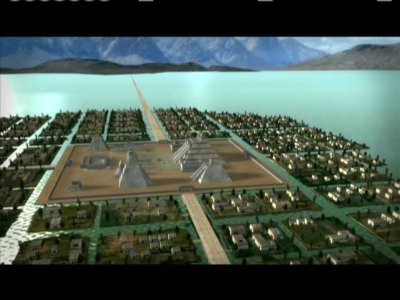
The DVD:
The Video:
As with most History Channel programs on disc, the widescreen, 1.78:1 video image is clear, sharp and bright. I saw no transfer issues.
The Audio:
The Dolby Digital English 2.0 stereo mix is lively and quite strong. There are, unfortunately, no close-captioning or subtitles options.
The Extras:
A brief, 18-minute Behind-the-Scenes featurette is included on the fourth disc, showcasing some of Weller's on-location conversations with various experts used for the series' production. frankly, I'd like to see more footage like this with Weller at his genial and animated best.
Final Thoughts:
Engineering An Empire is one of my favorite new series on The History Channel, showcasing the various structures, buildings and mechanical inventions that transformed emerging civilizations into empires. With the use of fun, informative CGI, and host Peter Weller's own personal expertise in historical studies, Engineering An Empire is both educational and energetically entertaining. Only the absence of the series' premiere episode Egypt mars this otherwise impressive first season box set (and keeps me from giving this a "Highly Recommended" rating). I recommend Engineering An Empire.
Paul Mavis is an internationally published film and television historian, a member of the Online Film Critics Society, and the author of The Espionage Filmography.


|
| Popular Reviews |
| Sponsored Links |
|
|
| Sponsored Links |
|
|
| Release List | Reviews | Shop | Newsletter | Forum | DVD Giveaways | Blu-Ray | Advertise |
|
Copyright 2024 DVDTalk.com All Rights Reserved. Legal Info, Privacy Policy, Terms of Use,
Manage Preferences,
Your Privacy Choices | |||||||









